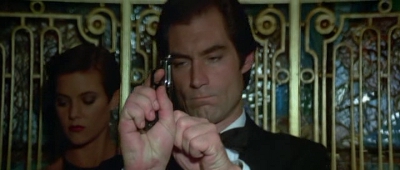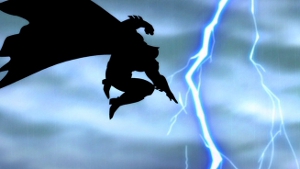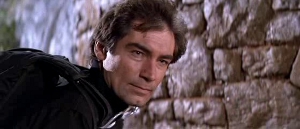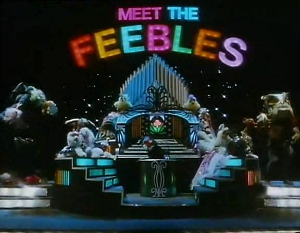Continue reading Halloween: The Curse of Michael Myers (1995)
Category Archives: Reviews
Trash Culture’s Final Fantasy Retrospective Part 4: Final Fantasy IV
by Chad Denton

And thus we enter the Golden Age…
Let’s get this out of the way first: not only did the game come out in the US as Final Fantasy II (and really, in the dark primordial age before the Internet, most of us who weren’t able to read Japanese or didn’t have subscriptions to trade magazines thought it really was Final Fantasy II), but Square sent us the “Easytype” version of the game. Back in the day, Square had a low opinion of American RPG players – perhaps with reason – so they gave us a version that not only was made easier, but had less combat options for the characters, because apparently having a main protagonist with a special attack that depletes his Health Points would melt our delicate brains. Continue reading Trash Culture’s Final Fantasy Retrospective Part 4: Final Fantasy IV
The Traumatic Cinematic Podcast: Hitchcocktober Episode I – The Phantom Sequel
 Hitchcocktober – our month-long celebration/exploration/exculpation of Alfred Hitchcock’s films – begins! Join the Traumatic Cinematic crew as we discuss 1960’s sub-genre creating masterpiece, Psycho, and it’s surprisingly-better-than-I-remembered-though-perhaps-my-standards-have-lowered-since-I-saw-it-last sequel, 1983’s Psycho 2.
Hitchcocktober – our month-long celebration/exploration/exculpation of Alfred Hitchcock’s films – begins! Join the Traumatic Cinematic crew as we discuss 1960’s sub-genre creating masterpiece, Psycho, and it’s surprisingly-better-than-I-remembered-though-perhaps-my-standards-have-lowered-since-I-saw-it-last sequel, 1983’s Psycho 2.
As always, if you’d like to keep up with the show, Like us on Facebook, or follow us on Twitter at @TCPodcastcrew, @GenXnerd, @Greymattersplat & @aytiws. And if you really love us, nominate The Traumatic Cinematic Show for the The 8th Annual Podcast Awards and earn our eternal devotion.
Licence to Kill (1989)

By now, EON Productions had these Bond films running on a rock-solid two year schedule. Writers Richard Maibaum and Michael G. Wilson seemed to have hit upon a winning formula: fuse the few remaining pieces of Fleming’s short stories together with plot elements “torn straight from the headlines of today’s newspapers.” This served the twin purpose of keeping James Bond “relevant” to a changing movie landscape and shaking up the stale formulas that had constrained the series for two decades.
Inevitably, the loudest criticisms of The Living Daylights and its sequel come from Bond fans who felt (and still feel) this series grand quest for “relevance” was a whole lot of tilting at windmills. The Dalton Era gets a lot of flack for a lot of things, but nothing more so than its lack of “fun”; that “campy” “charm” which supposedly made the Moore Era so much more “enjoyable” and the Connery films “instant classics.” Gods forbid anyone treat those like “serious” spy-fi action pictures…even if that’s exactly what they were intended to be.
They succeed on their own merits with no “camp,” required, save the kind the audience brings with it via the expectations in their heads. If you want real “camp,” I’ve got a version of Casino Royale you should check out (no, not that one)…me, I think Bond should’ve gone “darker” decades before he actually did. He might’ve stayed ahead of the trends instead of constantly playing catch-up. Licence to Kill almost does this and, on the strength of that almost, becomes my favorite Bond film of its decade…and the preceding one. Continue reading Licence to Kill (1989)
The Traumatic Cinematic Show, Ep. 34: Six String Samurai

Words can’t describe how psyched I was when Mike “@Greymattersplat” Wickliff suggested Traumatic Cinematic look at Six String Samurai. It remains one of my favorite movie of 1998, no question. And I’m even more psyched by the opportunity to tell as many people about this film as humanly possible. It’s a rare thing in this age of over-marketing: a genuine cult classic of independent American cinema. Listen, rate and review the show on your podcast provider of choice and get in contact with us, either through here or through TraumaticCinematic.com
Download the episode here (right click, “save target/link as”)
Trash Culture’s Final Fantasy Retrospective (Part 1A)

By Chad Denton
“Final Fantasy” fans who got hooked in the ’00s don’t know how lucky they were. Being an old-school fan, who was literally with the franchise from the start, was a weird ordeal for anyone living outside Japan and wasn’t enough of a hardcore gamer to own a genuine Famicon and have the ability to fluently read Japanese. The majority of the games in the series were simply not available to people unwilling to learn Japanese until the advent of the Internet, emulators, and fan-translations, and even if you did know enough Japanese to play the games it was still a hassle and an expense to actually order the games and a Famicon or Super Famicon to play them. To twist the knife, Square made the decision to title the real “Final Fantasy IV” as Final Fantasy II, which eventually created a huge (and now proverbial among console RPG fans) amount of confusion when saps like me finally got wise to the fact that all of North America was deemed unworthy to receive the series in full (I suppose it’s a good thing they ended the policy before “Final Fantasy VII” became “Final Fantasy IV.”) To make matters even more confusing, Square, despite the international success of the Final Fantasy franchise, decided that RPGs were unprofitable in the North American market and that the only RPGs that had any chance of selling had to be under the Final Fantasy brand name. So, when they did decide to release two other RPG franchises to North America, they released them as Final Fantasy Adventure and Final Fantasy Legend,despite the two series having almost nothing in common, even in gameplay, with any of the Final Fantasy games that did make it to North America and Europe. I never played “Final Fantasy Adventure” until fairly recently, but I did get to experience “Final Fantasy Legend,” albeit years after the series was first released on Game Boy. Continue reading Trash Culture’s Final Fantasy Retrospective (Part 1A)
Batman: The Dark Knight Returns, Part 1 (2012)
Introduction: Comic Book History You Don’t Care About But Need to Know in Order to Understand What the Hell’s Going On (with apologies to Linkara).

Yes, friends, it’s time once again to examine the hilariously over-praised work of comic book writer Frank Miller, whose slow slide into insanity, inanity and irrelevance has provided amusement to comic book fans for the last fifteen years. Before that, though – and still to this day in some corners of Bat-fandom – Miller is/was considered a godhead, the wellspring from which all modern conceptions of Batman flow.
This is patent bullshit, ignoring at least fifteen years of hard work by other creatives. My favorite Batman editor, Dennis O’Neil, started out as a front-line writer in 1969, and made the conscious choice to move Bats away from the campiness of his by-then-canceled TV show. Together with writer/artist Neil Adams, inker Dick Giordano and editor Julius Schwartz, O’Neil returned The Bat to his roots in the pulpy Crime Dramas of the 30s and early 40s. The SF elements common in American comic’s Silver Age either shuffled off to the background…or were not-so-subtly twisted to reflect the changing (or “evolving”…and I’d dare say “improving”) tastes of the 70s. This culminated in Steve Englehart and Marshall Rogers 1977 run on Detective Comics, now sold under the title Batman: Strange Apparitions.
For my cash, that marks the first appearance of a truly “modern” Batman, complete with all the baggage and angst that define him still today. O’Neil sent the First Robin, Dick Grayson, off the college, leaving Bats and Alfred alone in their mansion, just the way filmmakers (apparently) like it. Englehart and Rogers introduced the first of many Bruce Wayne love interests, inevitably moving him to question his crusade and its end game…before just as inevitably departing his life, leaving him with even more to brood about. Put those elements together, shake ’em up, add villains to taste, and you’ve got every (good) live action Bat-film to date…and through Batman’s influence, most of the Superhero sub-genre.
Continue reading Batman: The Dark Knight Returns, Part 1 (2012)
The Living Daylights (1987)

Introduction: Why Novels Are Better Than Films (Bond)
Enter Timothy Dalton, to the collective dismissal of a generation. Not my generation, mind – I was four at the time and at least a year away from achieving what I’d call “consciousness.” I speak of the previous generation of Bond fans Roger Moore created with his twelve year stint in the tux…and the generation before that, who grew to see Moore’s films as a fundamental betrayal of Ian Fleming’s creation and his suave, snarky, seemingly-detached counterpart Sean Connery and Richard Maibaum created.
Neither group seems particularly concerned with the fact Bond-the-character-in-these-films is an empty suit. As with most literary characters, translating Bond into film removes the one thing that made him bearable in prose: third-person-limited narration. Fleming’s novels are built out of it, their prose colored by Bond’s oft-irredeemable opinions on life, the universe, and everything. He’s exactly the type of “stiff-assed Brit” you’d expect to meet in the better clubs of mid-50s London: defiantly prim and proper; fussy and cynical and racist. Always making snap judgments on the most superficial of things*. But also experiencing the full range of human emotion in a way none of his actors can. They don’t have the time – most of their movies are already too long and none of the Connery or Moore films dared pause to show Bond agonize over a decision, or ruminate on a long life of forcing himself to do horrible things to worse people.
[*My favorite of these comes in the novel Moonraker – which had little to do with the movie Moonraker apart from the villain, Hugo Drax. Bond decides Drax is The Villain, not only because the man cheats at bridge, but because he sweats while he does it.] Continue reading The Living Daylights (1987)
Meet the Feebles (1989)

Not everyone has the balls to send their $250,000 alien invasion gross-out comedy to the Cannes Film Festival. Peter Jackson’s Bad Taste didn’t win any special jury prizes, but it did win the number one item on any filmmaker’s Wish List: international distribution. With that, Jackson secured himself and his friends (now collectively known as Wingnut Films) careers in show business…such as it was in the late-80s.
Not that you’d know it from Wignut Films output, which reverted back to short subjects in the wake of their first feature’s minor (but slowly growing, eventually cult-ish) success. The Japanese, for example, loved Bad Taste, and their country’s lack of public morality crusaders hypocritically draped in crosses and flags meant they got to see the whole damn film years before some of us. After some phone tag, Jackson and Co. secured funding for a short, satirical parody of Jim Henson’s Muppet Show from a Japanese TV network eager to sell something “from the director of Bad Taste.” This became the seed that sprouted Meet the Feebles. Continue reading Meet the Feebles (1989)
